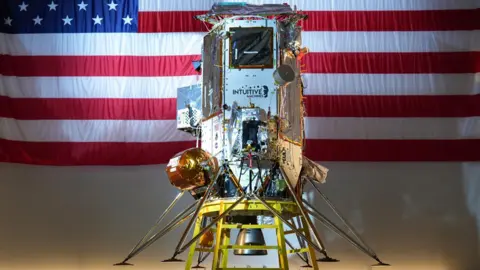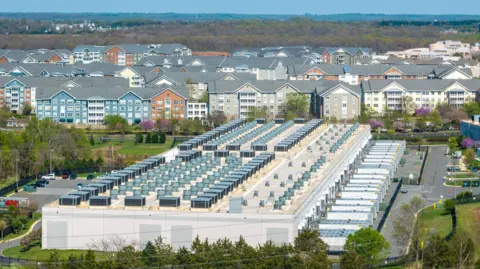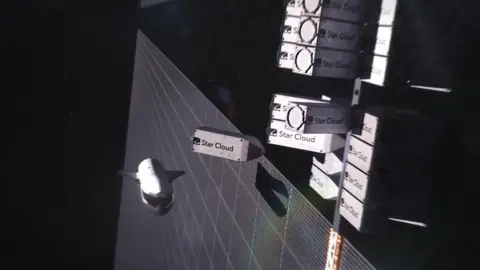Technology reporter
 Intuitive Machines
Intuitive MachinesIt sounds like something from a science fiction movie, but Stephen Eisele is confident that one day his company will open a data centre on the Moon.
“The way we see it is that by putting the data centre in space, you’re really offering unparalleled security,” says the president of Lonestar Data Holdings.
Last month, the Florida-based firm claimed to have successfully tested a tiny data centre the size of a hardback book that hitched a ride to the Moon on the Athena Lunar Lander from US space exploration firm Intuitive Machines. This, in turn, had been launched by a rocket from Elon Musk’s SpaceX.
Data centres are the vast warehouses that house stacks of computers that store and process data used by websites, companies and governments.
Lonestar says that putting them on the Moon will offer customers secure, reliable data processing, while taking advantage of unlimited solar energy to power them.
And while space-based data centres may sound far-fetched, it’s an idea that’s really starting to take off.
Part of the reason is rocketing demand and the difficulty of finding suitable sites on Earth.
The ever-expanding use of artificial intelligence (AI) computing has seen a massive increase in the amount of data that needs to be stored and processed around the world.
As a result, the need for data centres has shot up too, with annual demand set to rise between 19% and 22% by 2030, according to global management consultants McKinsey.
New facilities are springing up all the time – but it’s getting hard to find places to put them. Data centres are large and sprawling, and use enormous amounts of power and water for cooling.
And increasingly local people don’t want them built nearby.
 Hugh Kenny
Hugh KennyPutting data centres in space – either in orbit around Earth, or on the Moon – the theory goes, means they can’t do quite so much harm. There’s more-or-less unlimited energy available from the sun, for example, and no neighbours to complain about the environmental impacts.
Not only that, space-based data centres could specialise in services for spacecraft and other space facilities, with space-to-space data transfers quicker than from the ground.
Last summer, a European Commission-funded feasibility study into orbiting data centres published its results.
The Ascend report by carried out by Thales Alenia Space – a joint venture between French and Italian aerospace groups Thales and Leonardo – published its results.
It determined that deploying data centres in space “could transform the European digital landscape”, and be “more eco-friendly”.
Thales Alenia Space envisages building a constellation of 13 satellites measuring a combined 200m-by-80m, and with a total data processing power of around 10 megawatts (MW). That’s equivalent to a current medium-sized, ground-based data centre, with some 5,000 servers.
Based on technologies that already exist or are under development, the satellites would be assembled in orbit.
Damien Dumestier, Ascend project architect at Thales Alenia Space, says that for space-based data centres to be more environmentally friendly than existing ground-based ones it will be necessary to make the rocket launchers 10 times less emissive over their lifecycles. He says this looks possible.
“But in order to cover the new technology’s developments and the production capacity ramp-up to benefit from scale, we have to consider larger system capacity, around 200MW, meaning 200 of our envisaged large space infrastructures and 200 launches,” he says.
“The main question is when an adapted launcher will be ready. Depending on the investment and decisions to be taken, this could be done for 2030 or 2035, meaning commercial viability before 2037.”
However, despite this optimism from firms aiming to develop the technology, Dr Domenico Vicinanza, associate professor of intelligent systems and data science at Anglia Ruskin University in the UK, says there are numerous big hurdles before space-based data centres can be a viable proposition.
“Even with the contribution and advancements of companies like SpaceX, launching hardware into orbit remains extremely expensive,” he says. “Each kilogram sent into space costs thousands of dollars.
“Space-based data centres would require not only the data equipment but also the infrastructure to protect, power, and cool them. All of which add up in weight and complexity.”
Cooling the equipment will be a particular problem, because even though space is cold, conventional cooling systems don’t work will without gravity.
Meanwhile, space weather can damage electronics, while the ever-increasing quantity of space debris puts the physical hardware at risk.
Dr Vicinanza adds: “And fixing problems in orbit is far from straightforward. Even with robotics and automation, there are limits to what can be repaired remotely.
“A big hardware failure might necessitate a costly human mission, potentially making downtime stretch for weeks or months.”
 Starcloud
StarcloudYet firms like Lonestar are supremely confident, and say that they are responding to demand. “We wouldn’t be doing this if the customers weren’t asking us to,” says Mr Scott.
Its next target is to put a small data centre in orbit around the moon in 2027. Meanwhile, other companies are hoping to get there a bit faster, such as Washington state-based Starcloud, which is due to launch a satellite-based data centre next month, and start commercial operations in mid-2026.
Lonestar’s Mr Eidele says that space-based facilities offer more security for governments and businesses because their data does not need to be routed through terrestrial networks. Instead the information can be beamed directly from space to a dedicated ground station.
“It’s like having the vaults at the back of the bank,” he says. “You don’t have to open it every day, but it’s there to provide an extra measure of security, and the distance from the Earth to the moon offers that – it’s that much harder to hack, that much harder to access.”
The distance to the Moon means that data takes about a second and a half to reach the ground – this doesn’t matter for some applications, like longer-term data storage and backups.
And meanwhile, says Lonestar founder and chief executive Chris Stott, space-based data centres can help organisations meet regulations about data sovereignty – the need to hold peoples’ data in the country of origin.
“Under space law, that box of electronics is literally under the law of the licensing or launching state – it is an actual embassy in space,” he says.
Lonestar already has customers lined up, including the state of Florida and the Isle of Man government.









